
Organizing Food at Sea Menu: 1 2 3 4 5 6 7 8 9 10 11 12 13 14 15 16 17 18 Next>>
Organization of Ship's Food In the Golden Age of Piracy, Page 15
Officers In Charge of Food - Golden Age Pirate Quartermasters
There is a wealth of information about the important tasks a pirate quartermaster
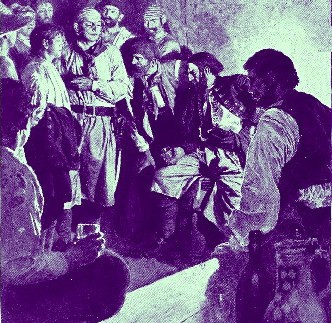
Artist: Howard Pyle - From Jack Ballisters' Fortunes (1894)
was to manage and the men who managed them during the golden age of piracy. During William Kidd's trial, Ignatius Pell testified that Kidd went by the title 'Commander in Chief' on the Adventure Galley, "but the Quarter-Master had more Power than he."1 In discussing the career of Thomas Tew, Charles Johnson said, "on board the West-India Privateers and Free Booters, the Quarter-Master's Opinion is like the Mufti's among the Turks; the Captain can undertake nothing which the Quarter-Master does not approve."2 Such statements make a pirate quartermaster sound like a very powerful officer. However, it must be recognized that each pirate ship's quartermaster had responsibilities unique to that ship and that crew. So even though a variety of examples exist which help define a quartermaster's role on a ship, they are not necessarily the same as the role of a pirate quartermasters on another ship. In fact, some crews did not appoint a quartermaster at all.3
With these things in mind, this section examines the six broad areas of responsibility of a GAoP quartermaster. These included: 1) representing the men, 2) managing the ship, 3) administering justice on the ship, 4) recruiting and keeping men, 5) overseeing captured ship boarding, 6) holding and dividing spoils, and 7) collecting, managing and distributing food. It then discusses some other notes of interest relevant to understanding the role of period pirate quartermasters. It finishes with a data-driven look at the individual pirate quartermasters active during this period.
1 "Tryals of Major Stede Bonnet and other Pirates", British Piracy in the Golden Age, Volume 2, Joel Baer, ed., 2007, p. 368; 2 Daniel Defoe (Captain Charles Johnson), A General History of the Pyrates, Manuel Schonhorn, ed., 1999, pp. 422-3; 3 Ed Fox, Piratical Schemes and Contracts, Thesis, 2013, p. 112
Golden Age Pirate Quartermasters - Representing the Men
Writing in 1724, the mysterious Captain Charles Johnson opined that the quartermaster on a pirate ship "is Trustee for the whole"1. He elsewhere suggests, "We may say, the Quarter-Master is an humble Imitation of the Roman Tribune of the People; he speaks for, and looks after the Interest of the Crew."2 Jacob du Bucquoy, a forced pilot for John (Richard) Taylor's crew captured off Mozambique in 1722, observed that "The quarter-master, who is the principal agent on board, leads the crew whose spokesman he is with the captain. ...[He] convokes general meetings, controls the captain’s decisions and very often
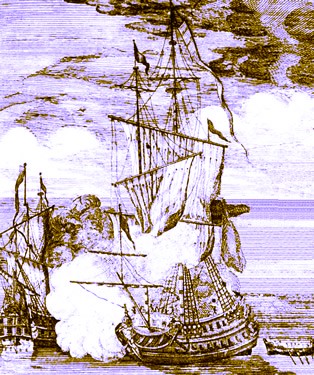
Artist: George Knapton
Henry Every's Fancy Engaging the Ganj-I-Sawai
dictates instructions to him in the name of the men."3 Of all the pirate quartermasters' responsibilities, this is the most challenging to illustrate with specific examples. Every other responsibility is an example of the quartermaster's trustee role in a way. However, this section focuses on the quartermaster's responsibility for representing the crew using the best examples found in period texts.
Much of this aspect of a pirate quartermaster's job suggests he be involved or even take the lead on the riskier sorts of things the pirates did. (This includes boarding captured vessels, but that will be discussed in its' place.) For example, when Henry Every's men arrived at New Providence, Bahamas with the wealth of the Moghul's Ganj-i-sawai aboard, an offering was collected to be given to island governor Nicholas Trott with "a deputation led by quartermaster Henry Adams and consisting of Robert Chinton, Thomas Hollingsworth and possibly one other was sent to Providence to hand over the cash."4 Once this was settled, Every brought the Fancy into the harbor to deliver her to Trott.
The quartermaster also symbolically represented the men's interests in the ceremony for newly elected captain John Bowen upon his installation aboard the Speedy Return in 1700 (as described by Charles Johnson):
...on his accepting the Office, he [the captain] is led into the Cabin in State, and placed at a Table, where only one Chair is set at the upper End, and one at the lower End of the Table for the Company's Quarter-Master. The Captain and he being placed, the latter succinctly tells him, that the Company having Experience of his Conduct and Courage, do him the Honour to elect him for their Head, not doubting his behaving himself with his usual Bravery, and doing every Thing which may conduce to the publick Good; in Confidence of which, he, in the Name of the Company, promised to obey all his lawful Commands, and declared him Captain. Then the Quarter-Master takes up the Sword, which he had before presented him, and he had returned, puts it into his Hand, and says, This is the Commission under which you are to act, may you prove fortunate to your self and us. The Guns are then fired round, Shot and all; he is saluted with three Chears; the Ceremony is ended with an Invitation from the Captain to such as he thinks fit to have dine with him, and a large Bowl of Punch is ordered to every Mess.5
Upon capturing William Snelgrave's Bird galley near the Sierra Leone River on the coast of
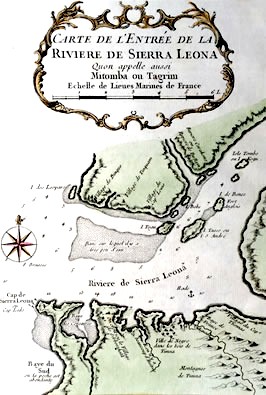
Cartographer: Jacques Bellin
The Mouth of the Sierra Leone River (1760)
West Africa in 1719, Thomas Cocklyn's quartermaster demanded that Snelgrave answer questions which would have been foremost in the mind of the pirate crew. He began by asking,
"Where the Captain was?" I told him, "I had been till now." Upon that he asked me "How I durst order my People to fire at their Boat out of the Steerage? saying, that they had heard me repeat it several times." I answered, "I thought it my Duty to defend the Ship, if my people would have fought." Upon that he presented a pistoll to my Breast, which I had just Time to parry before it went off; so that the Bullet past between my Side and Arm. The Rogue finding he had not shot me, he turned the But-end of the Pistol, and gave me such a Blow on the Head it stunned me; so that I fell upon my knees6
Cocklyn's QM seems to have gone a little too far.
Although tasked with representing the entire crew, pirate quartermasters sometimes chose to represent a fraction of the men who best reflected his own interests. In late 1693, Captain Thomas Tew wanted to capture five ships in an Indian convoy just after they had taken a sixth ship - a rich Indian dhow. However, "the Quarter-Master opposing him, he was obliged to drop the Design, and steer for Madagascar."7 Upon arriving at the island, the quartermaster decided it was "productive of all the Necessaries of Life; that the Air was wholesome, the Soil fruitful, and the Sea abounding with Fish, proposed settling; but only three and twenty of the Crew came into the Proposal; The rest staid with Captain Tew"8.
At other times, the captain chose to represent a minority faction. In August of 1696. some of Captain Kidd's men, including the quartermaster, wanted to attack a convoy of ships they had come across in the Indian Ocean. Kidd did not think it wise, however, instead deciding that they should wait and "we will take our choice of them in the morning"9. Upon daybreak, however, Kidd said that the convoy was too powerful for them and sailed away. This eventually led to a schism in the crew including both of his quartermasters, resulting in the majority of them leaving him at St. Mary's Island, Madagascar.10
1 Daniel Defoe (Captain Charles Johnson), A General History of the Pyrates, Manuel Schonhorn, ed., 1999, p. 213; 2 Defoe (Johnson), p. 423; 3 "Jacob du Bucquoy describes life in the company of John Taylor", Pirates In Their Own Words, Ed Fox, ed., 2014, p. 287; 4 Ed Fox, King of the Pirates, 2008, p. 108; 5 Defoe (Johnson), pp. 524-5; 6 William Snelgrave, A New Account of Some Parts of Guinea, 1734, p. 205-6; 7,8 Defoe (Johnson), p. 423; 9 "416. The Trial of Captain William Kidd, at the Old-Bailey", A Complete Collection of State Trials, Vol. 14, 1700-1708, 1816, p. 225; 10 Harold T Wilkins, Captain Kidd and His Skeleton Island, 1935, p. 91
Golden Age Pirate Quartermasters - Managing the Ship
As on legal voyage ships, the pirate quartermaster was responsible for steering the ship. In talking about pirate captain John Halsey, Charles Johnson mentions in passing that it was the Quartermaster's "Business... to be

Photo: Wiki user Qualiesin -
Queen Anne's Revenge, North Carolina Museum of History
at the Helm in Time of Chase or Engagement, according to the Rules of Pyrates"1. (Which 'Rules of Pirates' he might be referring to isn't clear; each pirate crew had their own set of articles which defined - more or less - their specific crew's 'rules'.) The quartermaster was often the man most trusted to guide a ship. When Blackbeard ran the Queen Anne's Revenge aground at Beaufort Inlet in May of 1718, he "sent his Quarter-Master to command this Deponent’s Sloop [David Herriot's sloop Adventure] to come to his Assistance; but she run aground likewise"2. (Unfortunately, Blackbeard's trust appears to have been misplaced.)
In addition to steering vessels, quartermasters were involved in a variety of other things concerned with ship management, particularly specifying duties for crewmen. At the trial of Bartholomew Roberts' men at Cape Coast Castle, Africa in March of 1722, two people said that the quartermaster of one of Robert's vessels assigned men to serve as sentinel on two different ships which they had taken.3 Richard Lazenby, an officer originally detained by pirates Jasper Seagar and John (Richard) Taylor, was "commanded up [into the masts] both by the Captain and Quarter-Master of the Pyrates, to tend the Braces on the Booms"4. In one unusual turn, after pirate captain Richard Bobbington was stranded ashore in the Gulf of Persia, those on his ship Charming Mary decided to leave him there, after which they "made no moves to elect a new [captain], and it appears that John Yarland shared the running of the ship with Henry Smith, the quartermaster"5. This suggests two quartermasters managed the ship by themselves with no one being designated captain.
1 Daniel Defoe (Captain Charles Johnson), A General History of the Pyrates, Manuel Schonhorn, ed., 1999, p. 465-6; 2 "22. David Herriot and Ignatius Pell on Blackbeard and Stede Bonnet", Pirates In Their Own Words, Ed Fox, 2014, p. 97; 2 "The Tryals of the Pyrates Lately Taken by His Britannick Majesty's Ship the Swallow", British Piracy in the Golden Age, Volume 3, Joel Baer, ed., 2007, p. 118 & 124; 4 Defoe (Johnson), p. 127; 5 Ed Fox, King of the Pirates, 2008, p. 146
Golden Age Pirate Quartermasters - Administering Justice On the Ship
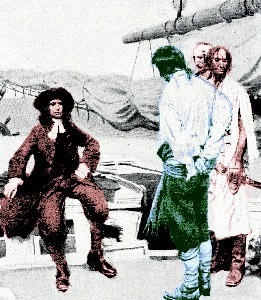
Artist: Howard Pyle
Colonel Rhett and the Pirate After the Fight (1901)
Forced pilot Jacob du Bucquoy observed that the Quartermaster in John (Richard) Taylor's crew was responsible for maintaining discipline. He expands quite a bit upon the magisterial duties of this pirate quartermaster, providing a detailed explanation of the proceedings.
When a crime has been committed by a member of the band, the quarter-master proceeds against him in the name of the law in front of a jury of a dozen members, of whom half are chosen by the accused. The latter, having presented his defence, retires, and the jurors pronounce judgement which the quarter-master executes with fairness and impartiality. He is not always so scrupulous when it is a question of punishing other infractions of the sworn law.1
If a disagreement between crew members was severe enough, it was settled by duel. du Bucquoy explains the process. When "quarrels arises on board, and the offence requires settling by force of arms, the quarter-master and the captain preside over the duel, which ends only with the death of one of the antagonists. A flag is then waved over the head of the victor."2 Charles Johnson, builds upon this explanation while explaining the meaning of Bartholomew Roberts' eighth article ('No striking one another on board, but every Man's Quarrels to be ended on Shore, at Sword and Pistol').
The Quarter-Master of the Ship, when the Parties will not come to any Reconciliation, accompanies them on Shore with what Assistance he thinks proper, and turns the Disputants Back to Back, at so many Paces Distance: At the Word of Command, they turn and fire immediately, (or else the Piece is knock'd out of their Hands:) If both miss, they come to their Cutlashes, and then he is declared Victor who draws the first Blood.3
Johnson's and du Bucquoy's descriptions
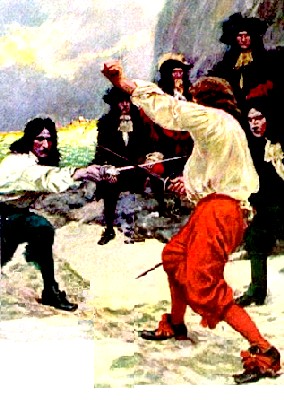
Artist: Howard Pyle
Theirs Was A Spirited Encounter Upon The
Beach of
Teviot Bay (1907)
do not include any examples of such trials or duels, although their specificity at least suggests having seen this happen in du Bucquoy's case and possibly interviewing a witness to such in Johnson's case. In a deposition made by Richard Luntly concerning Roberts, he hints that some such trial occurred after a pirate overheard him and other forced men discussing a plan to escape from the pirates. Luntly says this pirate "told Captain Roberts of it, and his Quarter-Master [Walter Kennedy], and immediatly all Hands were called up to know what they should do with us"4. Unfortunately Luntly stops short of giving the full details of what happened, only mentioning that they were to be marooned.
There are several examples of quartermasters administering 'off-the-cuff' justice. In his discussion of Roberts' articles, Johnson notes "Punishment of small Offences, which are not provided for by the Articles, and which are not of Consequence enough to be left to a Jury, ...the Quarter-Master... claims all Authority this Way"5. He goes on to list several such offences which include disobeying him, being quarrelsome with one another, misusing Prisoners, and failing to care for their personal weapons. "[H]e punishes [them] at his own Arbitrement, with drubbing or whipping, which no one else dare do without incurring the Lash from all the Ship's Company"6. Somewhat contrary to this statement, Johnson explains that when John (Richard) Taylor became captain of the Cassandra, it was 'his Privilege" to beat a man for complaining about the offence of complaining about not being set ashore by the pirates when they promised to do so.7 This may merely have been a difference between how punishment for 'small Offences' was handled between different crews.
Several examples of quartermaster justice are found in the trial of Roberts' men at Cape Coast in 1722. Keep in mind that
Photo: Dave Ley -
Cape Coast Castle in 2003
men defending themselves against a charge of piracy often said whatever they felt would make them look most innocent, which includes blaming the captain and quartermaster for forcing them to do things that would make them look guilty if they had done them of their own free will. However, these three testimonies come from men other than those accused, so they are (somewhat) likely to be truthful.
David Holliday testified that when the Onslow was taken, pirate Peter Lashly was "using his old Acquaintance[s] very cruelly, by driving them imperiously to work; and saucily commanding them to throw the Company's Goods in that Ship over-board, insomuch that the Quarter-master reprimanded him, and ask'd him how he dare do it since they were under his Protection?"8 Lashly appears to have gotten off fairly easy. George Ogle was called by the quartermaster to get "out of the [ship's] Boat several times, which he not obeying presently, beat him severely for it in [witness Benjamin Parr's] sight."9 John Stratton and George Fenn testified that William Philips had "quarrell'd with the Quarter-master, and was beat by another of the Pyrates."10 This last example is curious given that Johnson claimed in his description of Roberts' pirates that no one other than the quartermaster dare beat men for 'minor' offenses. In a related vein, Navy midshipman Clement Downing cited a story told to him by former pirate John Plantain on Madagascar wherein a man who had joined John Williams vessel Terrible out of a prize they captured "would have used his Captain and several of the Men very barbarously; but Roberts, who was then Quarter-master, would not allow of it."11
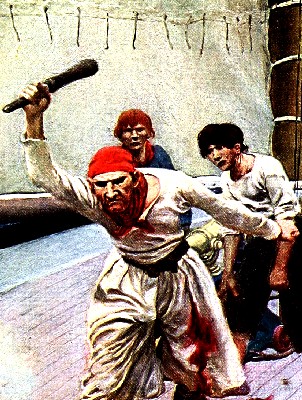
Artist: Howard Pyle
Then The Real Fight Began (1911)
A more sensational and perhaps somewhat more personally motivated example of a quartermaster (John Russel) attempting to administer 'justice' on a pirate ship comes from Philip Ashton's book. Ashton was a fisherman in what is today Nova Scotia who was captured by Edward Low in June of 1722 and forced to sail with them. He wrote a rather harrowing account of his captivity which included this observation of what happened when two of his fellow forced men attempted to escape:
the Quarter-Master came up to me cursing and swearing, that I knew of their Design to run away… I was forced to tell him, I knew not of their Design… This did not pacify the Quarter-Master, who with outrageous Cursing and Swearing, clapt his Pistol to my Head, and snap'd it, but it miss'd Fire. This enraged him the more, and he repeated snapping of his Pistol at my Head three times, and it as often miss'd Fire. The Quarter-Master, upon this, in utmost Fury, drew his Cutlash, and fell upon me with it, but I leap'd down into the Hold, and got among a Crowd that was there, and so escaped the further Effect of his Madness and Rage.12
Note that it was perfectly within his pirate-given right to chastise men for such behavior, although the way Ashton paints the picture, he did it as much from spite as duty. Another book, allegedly by George Roberts, paints Russel in a similar manner although it is likely fictional with the characterization of the quartermaster inspired by Ashton's own Narrative.
As already mentioned, rules differed between crews and the administration of punishment might be the prerogative of the captain. In addition, the quartermaster could be overruled by a strong captain. An example of this occurred when Francis Spriggs was Edward Low's quartermaster. Witness Richard Hawkins explained that when "a Man was killed on board of Loe in cold Blood; which being contrary to their Articles, Spriggs insisted upon having the Murderer hang’d.’ Spriggs was Low’s quartermaster at the time of the incident, but despite his position as the nominal dispenser of justice, Low overruled him and the murderer went free."13 Of course, if the crew disagreed strongly enough with a captain's actions, he was still technically an elected officer and could be removed from office.
1 "Jacob du Bucquoy describes life in the company of John Taylor", Pirates In Their Own Words, Ed Fox, ed., 2014, p. 287; 2 "Jacob du Bucquoy, p. 287-9; 3 Daniel Defoe (Captain Charles Johnson), A General History of the Pyrates, Manuel Schonhorn, ed., 1999, p. 212; 4 "27. Richard Luntly", Pirates In Their Own Words, Ed Fox, 2014, p. 124; 5,6 Defoe (Johnson), o, 213; 7 Defoe (Johnson), p. 127; 8 "The Tryals of the Pyrates Lately Taken by His Britannick Majesty's Ship the Swallow", British Piracy in the Golden Age, Volume 3, Joel Baer, ed., 2007, p. 138-9; 9 "The Tryals of the Pyrates Lately Taken...", p. 155; 10 "The Tryals of the Pyrates Lately Taken...", p. 90; 11 Clement Downing, A Compendious History of the Indian Wars, 1737, p. 107-8 - Note: In his book Sailing East - West Indian Pirates in Madagascar (2018), author Baylus Brooks advises, "One should be careful with the history given indirectly for Plantain through Downing", citing several details which do not agree with other established narratives. (p. 117-8). Still, this comment agrees with the one preceding it although it is not clear that John Williams or his quartermaster ever existed. For this reason, Williams/Roberts/the Terrible are not included in the list of pirates' quartermasters and their ships found in a later section; 12 Philip Ashton, Ashtons Memorial Strange Adventures and Signal Deliverance, 1726, p. 19-20; 13 Ed Fox, Piratical Schemes and Contracts, Thesis, 2013, p. 295-6
Golden Age Pirate Quartermasters - Recruiting and Keeping Men
The more men a pirate ship or fleet had, the more threatening they would appear to their prey: lightly-manned merchant ships. As a result, they were forever recruiting men from captured ships. These men sometimes came along willingly, other times under gentle threats and pressure and still other times by force. The quartermaster on some pirate ships was responsible both for recruiting men to bolster their numbers and monitoring and punishing those who planned or attempted to escape.
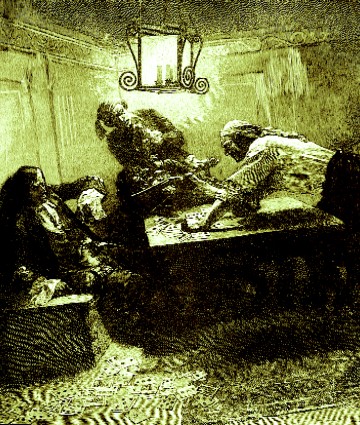
Artist: Howard Pyle -
Capture of the Galleon (1887)
George Roberts' quoted Edward Low's quartermaster John Russel about his role in recruiting new men. Russel explained, "He was Quarter-Master of the whole Company; and, by the Authority of his Place, he would enter the Mate [of Robert's ship] directly, and had a Pistol ready for the Man that should oppose him in it."1 Note that no such article appears in Low's articles as found in the Boston Newsletter.2
There are several examples of a pirate quartermaster forcing men from other ships to join a pirate crew. Some of these instances involved the quartermaster threatening or actually abusing a man to get him to join. During the trial of Bartholomew Roberts' men, witness Edward Crespe testified "that he saw the Quarter-master force him [George Smithson] out of the Ship [Tarlton] with Violence, tho' he cry'd and pleaded much against it."3 Nicholas Lewis, one of Edward Low's quartermasters aboard the Merry Christmas, testified that "that he himself had forced both these men [Henry Winn and Henry Watson], and that they never acted in concert with the pirates; and particularly that he had whip't Watson twenty six times, but could not prevail with him to sign their articles.4Other instances just involved the quartermaster forcing the desired men aboard the pirate ship before they left their captured prize. "George Smithson and Roger Pye says, he [Henry Graves] belonged to John Tarlton, the same Ship they did when taken by the Pyrates; and that he saw David Simpson the Quarter-master drive him out of the Ship, from which he went crying"5.
Some of the testimonies in the trial or Robert's men were
less definite as to whether the man being tried was willing or not to join the pirates. Thomas Gerrat 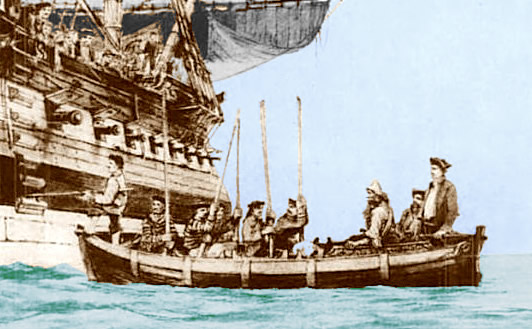
Man Being Brought Aboard, From Desperate Journeys, Abandoned Souls by Robert E Leslie (c. 1859)
was "fetched out of the Old Fortune by the Quarter-master, who swore he should go, and pull'd him by the Hand, he crying very much, Archibald Ker a Passenger in the Onslow, also swears, he saw him go over the Side without any Reluctancy; yet heard the Quarter-master say he must go and believes he came purposely for him."6 Even less convincing, prisoners sometimes offered the fact that they were forced by the quartermaster in their own defense. "The Prisoner [James Cromby] says, he was taken August last in the Onslow, and order'd out by the Quarter-master"7, suggesting that he wasn't responsible for their being on the pirate ship. Cromby's statement hardly makes his case, but it it probably wouldn't have mattered because courts rarely believed such testimonies.
When coercion didn't work, the pirates might try to cajole men into joining them. Fisherman Philip Ashton gives a vivid description of such efforts after he was captured.
I was led down into the Steerage, by one of the Quarter-Master's, and there I was assaulted with Temptations of another kind, in Hopes to win me over to become one of them; a number of 'em got about me, and, instead of Hissing, shook their Rattles, and treated me with abundance of Respect and Kindness in their Way; they did all they could to sooth my Sorrows, and set before me the strong Allurement of the vast Riches they should gain, and what mighty Men they designed to be, and would fain have me to join with 'em and share in their Spoils8
Ashton was not to be convinced and continued to refuse to sign their articles.
The other aspect of some pirate quartermasters' duty concerned making sure that already secured men didn't
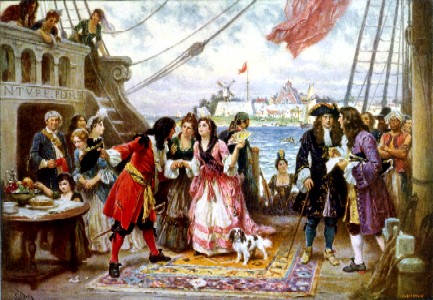
Artist: Jean Leon Gerome Ferris -
Captain Kidd in New York Harbor (1932)
try to leave the crew. When Captain Kidd was in New York recruiting men for his (then) privateer voyage, his original9 fourth article read: "If any man shipps himselfe aboard ye said shipe and should offer to goe away from her, he shall suffer what punishment ye Capt. and ye Company Quarter-Master shall think fitt, and shall have no share."10 George Roberts mentions an article on Edward Low's ships supporting this as well: "...if any of the Company shall advise, or speak any thing tending to the separating or breaking of the Company, or shall by any Means offer or endeavour to desert or quit this Company, that Person shall be shot to Death by the Quarter-Master's Order, without the Sentence of a Court-Martial."11 Once again, however, this is not found in the articles printed in the Boston Newsletter so it must be taken with a grain of salt given the questions surrounding the authorship of this book. Other pirate articles also address the punishment of men caught trying to escape12, although this is the only one to tie a punishment for such an attempt directly to the quartermaster.
1 George Roberts, The four years voyages of capt George Roberts, 1726, p. 80; 2 See Ed Fox, "Piratical Schemes and Contracts", Thesis, 2013, p. 322-3; 3 "The Tryals of the Pyrates Lately Taken by His Britannick Majesty's Ship the Swallow", British Piracy in the Golden Age, Volume 3, Joel Baer, ed., 2007, p. 106; 4 CSPC, America and West Indies, Vol. 34. Item 102; 5 "Pyrates Lately Taken...", p. 153; 6 "Pyrates Lately Taken...", p. 146; 7 "Pyrates Lately Taken...", p. 119; 8 Philip Ashton, Ashton's Memorial Strange Adventures and Signal Deliverance, 1726, p. 15; 9 This comes from the original articles Kidd created for his privateering voyage which were modified by his crew after leaving New York. However, the revised articles do not contain an article equivalent to this one. The new 9th article said, "That whosoever shall disobey command shall lose his share or receive such corporall punishment as the Capt and major part of the company shall think fit." and the new twelfth article read "That man that shall breed a mutiny or ryot on board the ship or prize taken shall lose his share, and receive such corporall punishment as the Capt and major part of the company shall think fitt." Although related to the original fourth article, they fail to mention the quartermaster in any way. See Fox, p. 310-2; 10 Harold T Wilkins, Captain Kidd and His Skeleton Island, 1935, p. 36; 11 Roberts, p. 62; 12 Among these, John (Richard) Taylor's article: "Deserters are condemned to have their ears and noses slit and be marooned naked on a deserted island." (Fox, p. 315), Bartholomew Roberts' ninth article: "No man to talk of breaking up their way of living, till each had shared one thousand pounds." (Fox, p. 318) Thomas Anstis' eleventh article: "If any time we shall come in Company with any other Marooner and they shall offer to sign their articles without the consent of the Company shall be Marooned, or run away shall receive the same." (Fox, p. 320), and John Phillips second article: "If any man shall offer to run away, or keep any Secret from the Company, he shall be marroon'd with one Bottle of Powder, one Bottle of Water, one small Arm and shot." (Fox, p. 324)

